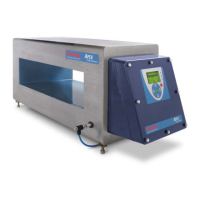Thermo Scientific APEX User’s Guide Page 11
Getting Started
Congratulations on the purchase of your new Thermo Scientific APEX metal detector!
The first thing to do is unpack your detector and complete the electrical installation and
application-specific mechanical set-up. For instructions on how to do this, go to
page 283.
Now that your APEX™ detector is properly installed, you are ready—and, we hope,
eager—to learn how to use it. Here, in outline, is what you will learn in this section.
Setting Global and Application-Specific Parameters
Once the detector is installed and ready to check your products for the presence of
metallic contaminants, you will use the detector’s control panel to set up various global
and application-specific parameters. In this manual, the term “product” refers to
anything you are testing for the presence of metallic contaminants. Whenever you
encounter a technical term you do not understand in this manual, please go to the
Glossary on page 393 for a brief explanation.
Global parameters are ones that you pretty much “set and forget,” because they define
how you want the detector’s display screen to appear, what language and units (feet or
meters) you prefer to use, and so on. In other words, global parameters are ones that
you will not change very often.
In contrast, application-specific parameters are ones you use to get your particular type
of application (conveyor, gravity-feed, pipeline, or pharmaceutical) set up and running
properly. Application-specific parameters sometimes need to be fine tuned to optimize
the detector’s performance for your particular operating environment.
Setting Product Parameters
You use the detector’s control panel to set up various product parameters. The most
critical product parameters you need to set are the following.
• Values for the X and R Noise Thresholds
The X and R thresholds are background noise thresholds that are learned by the
detector with no product present. In conveyor applications, the thresholds are
learned with the conveyor running, but with no product present on the conveyor
or in the search head. Similarly, in gravity-feed, pipeline, and pharmaceutical
applications, the thresholds are learned with no product present in the duct, pipe
or chute. When the X and R noise thresholds are exceeded, they indicate the
presence of product—as shown by the activation of the green product-LED on the
detector’s control panel.
• The Detect-Level Value
Any signal from the detector’s search head that exceeds the detect level, will be
tagged as a contaminant. As a general rule, the detect level should exceed the
level of the background noise by a factor of 2–3 times.

